If you know much about growing hydrangeas, you know that the pH levels of the soil changes the colors of the blooms on these beautiful flowers. Did you know that at least two varieties aren’t affected, though? Meet phantom hydrangeas vs. limelight hydrangeas; two stunning varieties that break the mold of the already unique plant species.
Of course, the two varieties of hydrangea have some strong similarities, but there are some distinctive differences, too, which can help you tell them apart and decide which variety is best for your garden. Let’s take a look!
| Phantom Hydrangea | Limelight Hydrangea | |
|---|---|---|
| Classification | Hydrangea paniculata ‘Phantom’;Between 23 and 80 species, depending on who you ask | Hydrangea paniculata ‘Limelight’; There may be up to 80 species of hydrangeas |
| Description | Phantom hydrangeas have huge conical blooms up to 15 inches long, whose colors change from month to month, from white to green, to pink | Limelight hydrangeas have large 10-inch blooms that start out as lime green and shift into darker shades of pinks and reds |
| Uses | These flowers may be used as hedge rows, privacy fences, dried flowers, cut flowers, and large container flowers for outdoor and indoor spaces. In past, hydrangeas have been used medicinally for digestive tract health issues, though no scientific evidence supports this use. | Limelight hydrangeas make for perfect fence borders, specimen pieces, and house borders. They’re also commonly used for drying flowers and cut flowers. Like Phantom hydrangeas, they have been used medicinally in the past, but no specific scientific study indicates this is effective or useful. |
| Origins and growing preferences | Phantom hydrangeas come from the panicle hydrangea family, meaning they originated in southeastern China, eastern Russia, parts of Korea, and Japan. They grow in Zones 3 to 8 and thrive in full to partial shade, depending on climate. | Limelight hydrangeas are part of the panicle hydrangea family, meaning they originated in Japan, Russia, China, and Korea. They thrive in full sun in cooler climates and partial shade in warmer climates in Zones 3 to 8, with slightly acidic soil. |
| Special features or fun facts | Phantom hydrangeas are one of the few varieties of hydrangeas that isn’t affected by pH levels in the soil. The blooms shift from white to pink throughout the flower’s lifetime. | Limelight hydrangeas also are not affected by pH levels in the soil when it comes to flower colors. Instead, the flowers begin as lime green or chartreuse and shift in darker shades of pinks and reds as they mature. |
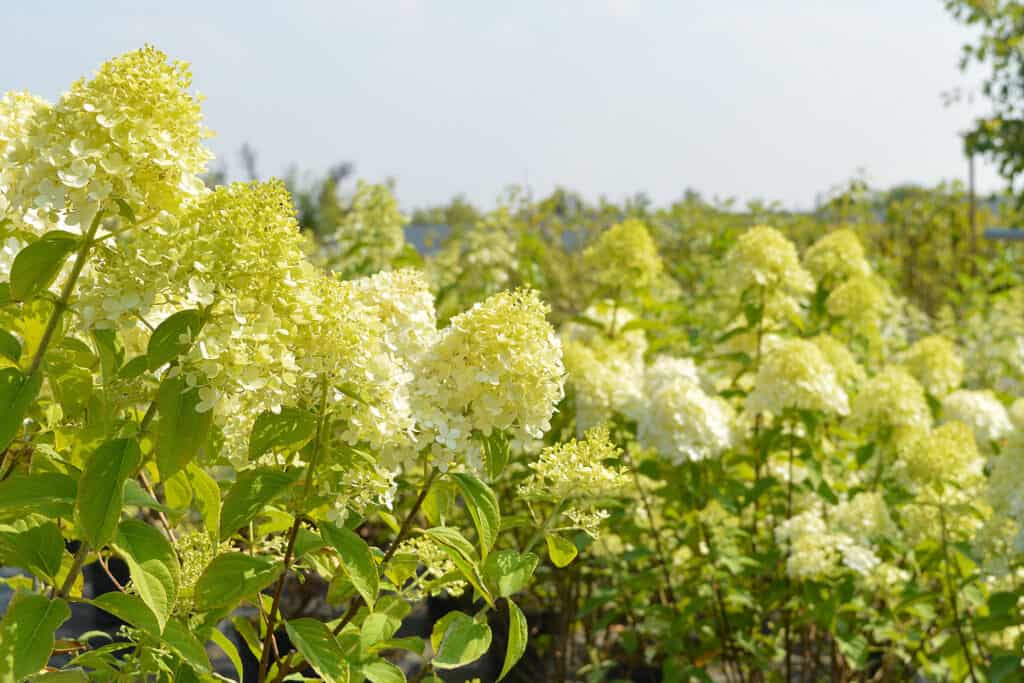
Limelight hydrangeas with mixed chartreuse and white blooms
©Mari_Piman/Shutterstock.com
Key Differences Between Phantom Hydrangea and Limelight Hydrangea
Phantom hydrangea vs. limelight hydrangea obviously have several things in common, but there are some differences in their histories, looks, and more.
Phantom Hydrangea vs. Limelight Hydrangea: Classification

Limelight hydrangea flowers up close
©Bonnie Taylor Barry/Shutterstock.com
There are many varieties of hydrangeas, some of which look and act remarkably similar, while others have widely different characteristics. Each has a specific nickname or type attached, with this name often attached to the scientific name. In this case, we are looking at the Hydrangea paniculata ‘Phantom’ and the Hydrangea paniculata ‘Limelight’. Both are deciduous shrubs in the Hydrangeaceae family and bear the common name of panicle hydrangea.
The Phantom hydrangea and Limelight hydrangea, however, have many differences in their sizes, looks, flower shapes, and more, which helps them to stand apart and makes them identifiably different, if you pay close attention to the details.
Phantom Hydrangea vs. Limelight Hydrangea: Description

Phantom hydrangeas shifting into that deep pink color
©Marina.Martinez/Shutterstock.com
Phantom hydrangeas are panicle hydrangeas deemed as having the largest flower heads of all the hydrangea species. The flower clusters grow in conical shapes up to 15 inches long. The flowers change colors throughout their blooming season, beginning in shades of white and ending up pink by the fall. They are heavy blooming plants that grow up to 10 feet in height, with a spread between 6 and 10 feet, blooming from July to September.
Limelight hydrangeas are also a deciduous shrub that loses its leaves in winter. They, too, are panicle hydrangeas with large blooms that reach up to 10 inches, growing in “football” shaped clusters. The plants reach heights of 6 to 8 feet, with a 6 to 8 foot spread, blooming from July to September. The flowers also mature in color, beginning in lime or chartreuse green and aging into rose pinks. The bushes themselves grow in rounded shapes with dark green foliage.
Phantom Hydrangea vs. Limelight Hydrangea: Uses
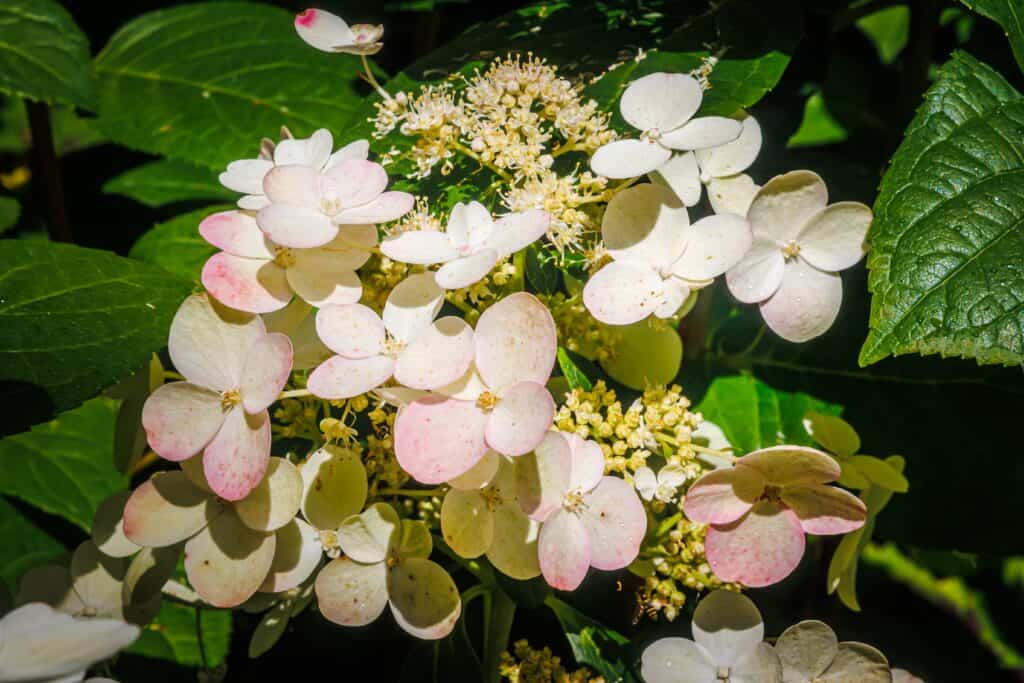
Phantom hydrangeas often have multiple colors on the same plant at the same time as they shift with seasons.
©nnattalli/Shutterstock.com
Hydrangeas are known for many things, including and especially making stunning border plants for gardens and houses. Both limelight and phantom hydrangeas, though, have huge blooms and grow fairly tall plants, so they particularly make for excellent borders, privacy walls, woodland borders, and specimen pieces for show gardens. They grow well along fences and walls, as well, and do stunning “work” as grouped plants. They may also be grown in large containers for patios and decks, or, in some cases, indoor plants, if properly cared for.
Many people appreciate both species of flowers as both cut and dried flowers and the blooms are often used for natural dyes for fabrics.
Hydrangeas have also long been used for herbal remedies and medicinal purposes. Primarily, the rhizome and roots are used to treat bladder infections, kidney stones, and other digestive system infections and ailments. There is, however, no specific scientific discovery that would promote the use of the plant in these ways. Future studies may show the effectiveness someday. You should never simply use a plant for treatment in this type of manner, however, but first consult a medical care provider for uses, benefits, and helps on discussions of such remedies.
Phantom Hydrangea vs. Limelight Hydrangea: Origins and Growing Preferences
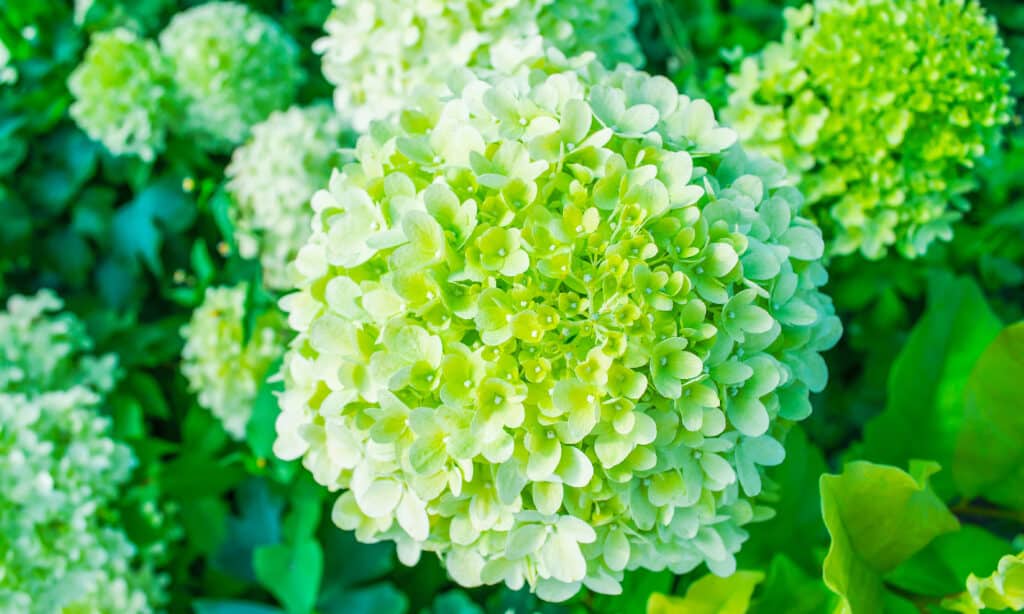
Bold green limelight hydrangeas showing off their early shades
©iStock.com/Valentyna Tymchenko
The Phantom hydrangea, along with other panicle hydrangeas, is a hybrid of the Hydrangea paniculata, a native of Japan, southeastern China, eastern Russia, and parts of Korea. The plant grows at altitudes up to 4,000 feet in the regions where it grows natively. The plant was brought over to Europe in the 1700s and later to the Americas where it has thrives, thanks to the climate. Ultimately, however, there are actually fossil records that show early ancestors of the hydrangea were in North America some 23 million years ago. The Phantom hydrangea itself specifically earned the Award of Garden Merit from the Royal Horticultural Society in 2008.
The Phantom hydrangea does best in Zones 3 to 8, in full sun to partial shade. You may find the plant at nurseries or through online websites like Etsy, garden shops, and similar, as well, though it’s always recommended that if you can purchase plants in person, this is your best bet for ensuring healthy plants. Phantom hydrangea need nutrient-rich soil but will otherwise do well in soils with a wide variety of pH levels. And since its floral shades are consistent, you won’t need to mess with the pH levels to get the desired color for the flowers like you need to do with other hydrangeas.
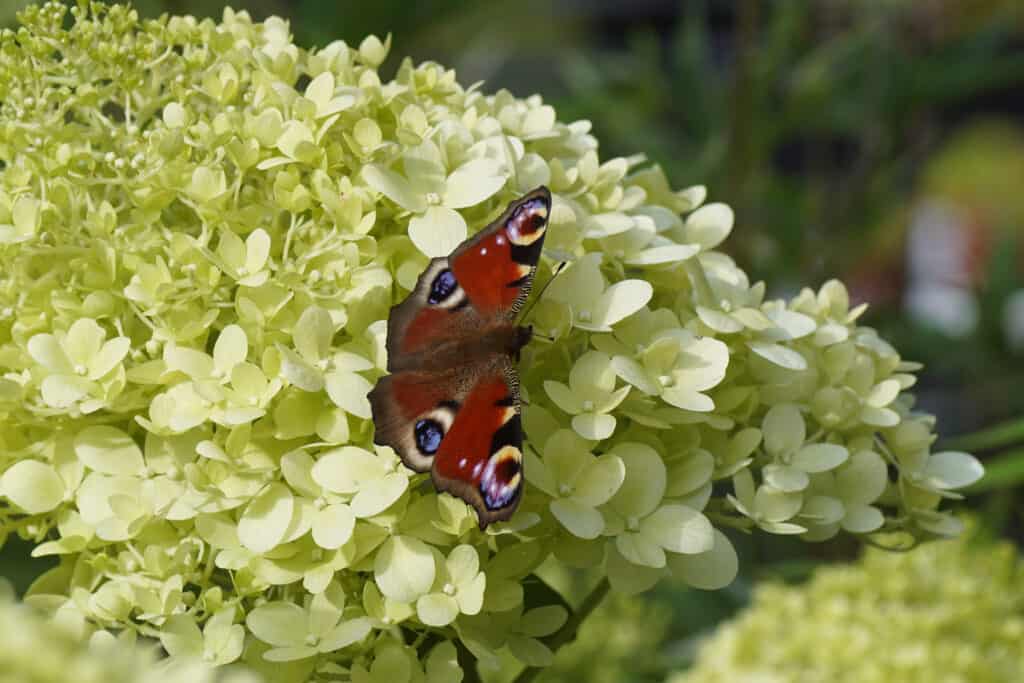
Both varieties of hydrangeas attract pollinators.
©Thijs de Graaf/Shutterstock.com
Limelight hydrangeas are also part of the panicle hydrangea family, so to a certain extent have the same history. However, this particular variety came about in 1986 when Pieter Zwijnenburg, a breeder from Boskoop, Netherlands, crossed two unpatented varieties of panicle hydrangeas to create the lovely limelight variety we know and love today.
This variety also does best in Zones 3 to 8, with plenty of sunshine needed. In warmer climates, plant limelights in partial sun with morning light and in northern (colder) climates, plant them in full sun, with wind protection. They’ll do best in slightly acidic soils with pH between 6.1 and 7.0.
You can technically plant hydrangeas from seeds and if you’re skilled in this area, you may well wish to, but most folks do better planting established plants of at least 2 years.
Phantom Hydrangea vs. Limelight Hydrangea: Special Features and Fun Facts
Phantom hydrangeas are one of the few hydrangeas that aren’t affected by the pH of the soil. Instead, the blooms pop out in shades of white and off-white and warm into shades of green in July, then turn pink as the flowers mature, darkening as the season turns to fall. The flowers on this particular species of hydrangea are exceptionally hardy and part of what makes this variety really stand out.
Limelight hydrangeas were birthed from two unidentified hydrangeas that had never been patented. The huge flowers helped to revive the popularity of hydrangeas as they also shift colors as the blooms mature. They begin with green shading and deepen into other shades in the red family, from pinks and reds to burgundies.
Both are panicle hydrangeas, which means they have the largest flower heads of hydrangea species, often getting at large as 15 inches in size.
Bonus: Hydrangeas Not Blooming? We Have the Answers
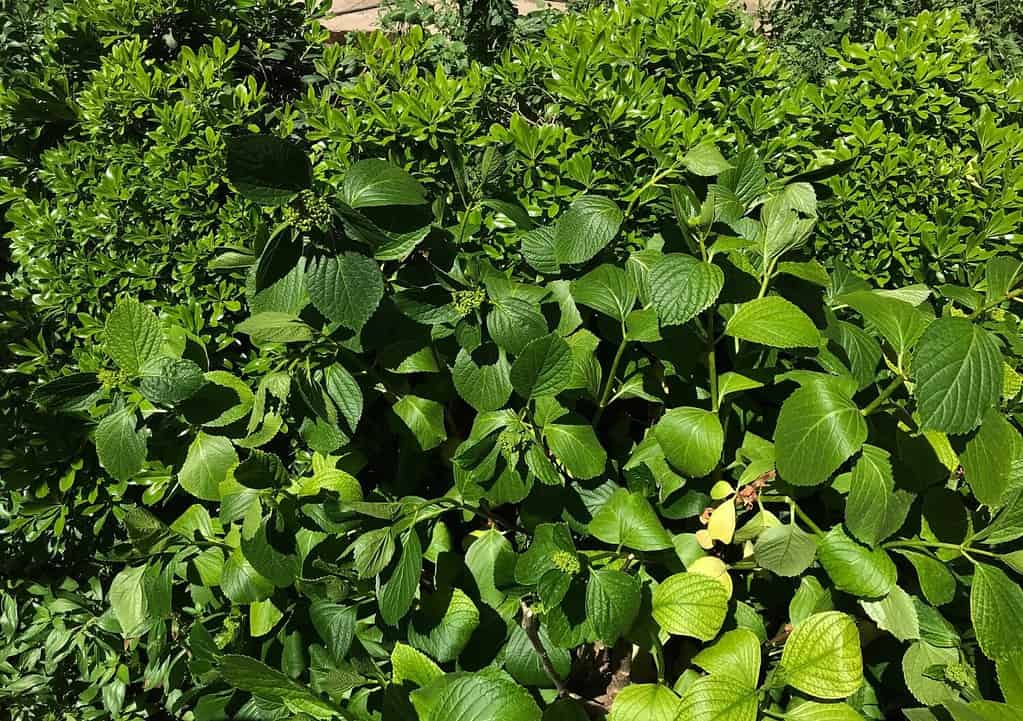
Hydrangeas that fail to bloom are a sad sight.
©Hatice Sever/Shutterstock.com
If you look forward to seeing your hydrangeas bloom every year – it is a great disappointment when those big showy blooms never come. The leaves are lush and green but either buds never form or don’t develop – what has gone wrong? There are many things that can keep your hydrangeas from blooming – here are some reasons and solutions:
- Too Much Shade. Depending on the variety – most hydrangeas can tolerate a little shade – but most need several hours of direct morning sun. Consider moving your plant to a better location.
- Too Much Sun. Apparently, a sweet spot must be found for these plants. Too much direct sun may stress the plants causing them to conserve energy by not flowering.
- Improper Pruning. It is crucial for you to learn whether your hydrangea variety blooms from old wood or new – and prune accordingly. Bigleaf, oakleaf, climbing, and mountain varieties all bloom on old wood. Unless they get too big – it’s best not to prune them at all. The blooms will dry out and be replaced with new flowers next season. Panacle and smooth varieties bloom on the current season’s growth. (Limelight and White Wedding) Prune these in late winter or early spring.
- Cold Weather. A harsh winter or hard freeze can damage developing flower buds, which may result in a summer with no flowers. Mulch the area around the base of the plants in fall with several inches of leaves or straw to insulate roots. Protect plants with a covering during cold spells or frosts.
- Not enough water. Hydrangeas need a lot of water to do well. Too little water can result in stunted growth or no blossoms the next season. If plants are drooping or wilting they need to be watered immediately.
- They are too young to bloom. It can take newly planted hydrangeas up to 5 years before they begin blooming. You can buy larger plants if you want flowers sooner.
The photo featured at the top of this post is © Mike Russell/Shutterstock.com
Sources
- Missouri Botanical Garden, Available here: https://www.missouribotanicalgarden.org/PlantFinder/PlantFinderDetails.aspx?taxonid=443856&isprofile=0&
- Missouri Botanical Garden, Available here: https://www.missouribotanicalgarden.org/PlantFinder/PlantFinderDetails.aspx?kempercode=c192
- Monrovia, Available here: https://www.monrovia.com/phantom-panicle-hydrangea.html
- This Old House, Available here: https://www.thisoldhouse.com/gardening/reviews/limelight-hydrangea-trees
- Proven Winners, Available here: https://www.provenwinners.com/plants/hydrangea/limelight-panicle-hydrangea-hydrangea-paniculata
- My Garden Life, Available here: https://www.mygardenlife.com/plant-library/6234/hydrangea/paniculata/phantom
- Chicago Botanic Garden, Available here: https://www.chicagobotanic.org/plantcollections/plantfinder/hydrangea_paniculata_phantom--phantom_panicle_hydrangea
- Augusta Chronicle, Available here: https://www.augustachronicle.com/story/lifestyle/2018/07/19/campbell-vaughn-limelight-hydrangeas-bring-explosions-of-white-to-landscapes/11445703007/
- WebMD, Available here: https://www.webmd.com/vitamins/ai/ingredientmono-663/hydrangea
- Chicago Botanic Garden, Available here: https://www.chicagobotanic.org/plantcollections/plantfinder/hydrangea_paniculata_phantom--phantom_panicle_hydrangea
Thank you for reading! Have some feedback for us? Contact the AZ Animals editorial team.






